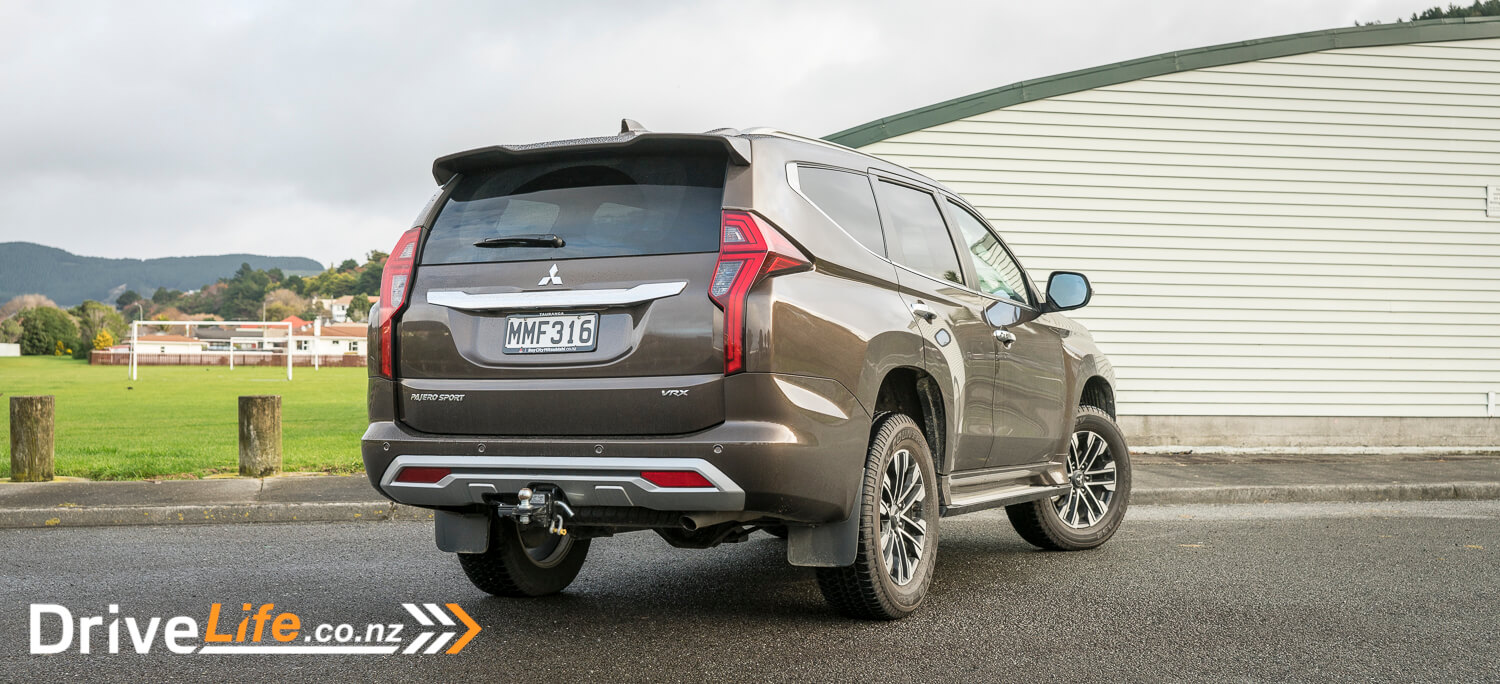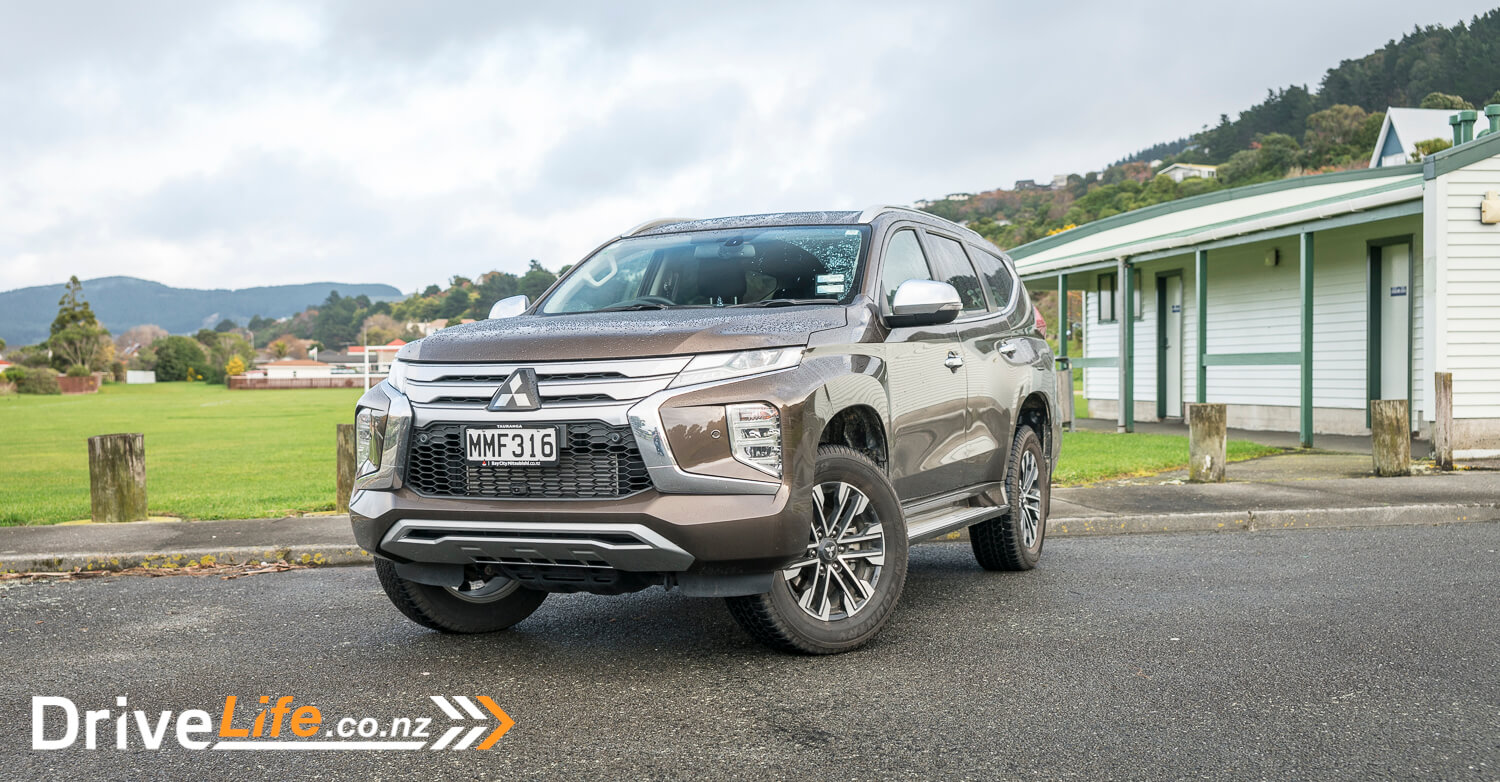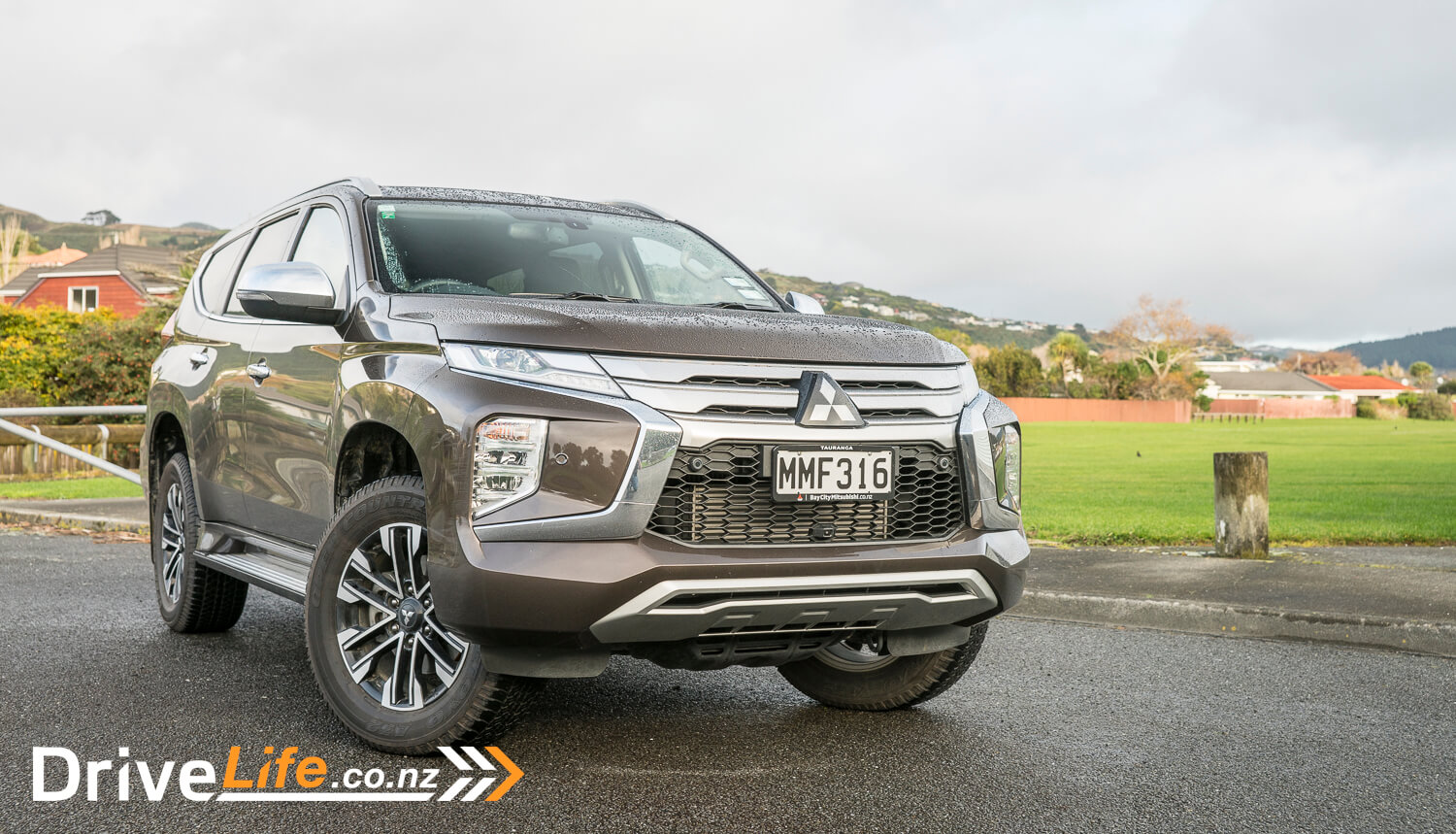Back in 2017 I reviewed the Mitsubishi Pajero Sport XLS and loved it. I gave it a 5 chevron review as it was well rounded vehicle that gave you a lot of bang for your buck. It’s now 2020 and we have the latest Pajero Sport VRX to review and see how it stacks up to the previous model.
It’s easy to mix up the two Pajeros available in New Zealand. There is the standard large Pajero and the Sport. Both have the same name, however the Sport is not a variant of the Pajero, it’s a different model altogether. A tad confusing I know.
The Sport is the funky young and hip version of what the normal Pajero would like to be, with a more streamlined look. When we reviewed the Pajero Sport in 2017 the price difference between the two models was significant; times have changed and this difference is now down to $1000.
Would this now affect decisions made on the Pajero Sport when the larger Pajero is not much more?

What’s in The 2020 Mitsubishi Pajero Range?
In New Zealand, the Pajero Sport has only one variant available, the 2.4D VRX 4WD. The VRX starts at $58,990 + on-road costs. The Pajero Sport comes with a 2.4L MIVEC Intercooled Turbo Diesel engine which creates 134kW@3500 rpm and 437Nm@2500 rpm, and it’s factory rated with a fuel consumption rating of 8 litres per 100km.
The highlighted features of the VRX includes: a 2.4-litre turbo diesel engine, 8-speed automatic transmission, adaptive cruise control, forward collision mitigation, rear cross-traffic alert, 360° multi around view monitor, leather-appointed interior, heated and powered front seats, blind-spot warning, power tailgate, super select 4WD and 3.1-tonne braked towing. Something to note is that the larger Pajero only has a 3.0-tonne braked tow rating.
The VRX has all of the above and is available in a range of colours, Pitch Black, Sterling Silver, White Diamond, Midnight Blue, Redwood, Deep Bronze and Graphite Grey. Our review vehicle was Deep Bronze, or as a Google phone colour choice, kinda brown. Mitsubishi also offers a wide range of extra features to personalise your Pajero Sport. These include: weather shields, roof racks, rear air dam, front air dam, cargo liner, sidestep garnish, scuff plate, carpet mats and fender flares.

First Impressions Of The 2020 Mitsubishi Pajero Sport 2.4D VRX 4WD
I was looking forward to my time in the Pajero Sport, as I had really enjoyed the experience in the previous XLS. I was curious to know what had changed and if it would still tick all the boxes for me. Upon first glance, one box didn’t get ticked, the colour selection. Thankfully when buying you get to pick the one you want, not always the luxury we have when reviewing vehicles.
On the face of it, it doesn’t feel like much has changed when I think about the previous model. But when you have them side by side, you can see the evolution. The previous model’s lines were softer overall, now replaced with a sharper, stronger look. The front has squared up with a larger front grille and cleaner lines ending with the sleek LED headlights. The rear has seen similar changes, now with only the VRX the spoiler is standard and the rear hatch is recessed into the body unlike its predecessor.
Overall these resulting changes make it feel the same but in fact it’s rather different.

What’s The Inside Like On A 2020 Mitsubishi Pajero Sport 2.4D VRX 4WD?
I’ll be honest and say I could not tell the difference with the new interior from memory. But once I looked back at the photos from the previous review, they were both very similar with some differences. The only real differences are the central console, media display and seats. Everything else is the same or at least the same shape and feel. This is not a bad thing, as the Pajero is a well put together unit. All the surfaces are hard plastic or tough material so that they can endure the rougher times when getting in and out when off the beaten track
The seats in the VRX are now leather, which was a bit of a surprise. I know the VRX is the top and only spec. But the Pajero Sport is a hard worker and always ready for a bit of fun and and offroad adventure. Leather seats are almost too nice for something you might jump in and out of, wet, muddy or dirty. The previous model had cloth seats, which I loved. Now with leather seats, does this affect the useability of it, would you become too precious about them? Can’t throw your tools or dirty overalls in the back seat and what about kids? It’s something to think about, something I am not sure that needed to change. I also did not find the leather seats as comfy as I remember the cloth seats from the previous model
The other thing I noticed getting in and out of the Pajero Sport, is that the roof was very close to my head and I had to duck just a bit to get under the A-pillar. Something I had not noticed before. As my normal daily SUV is a Land Rover Discovery 4, the space around my head was noticeably different in the Pajero

The dash has seen big changes too, from the standard dials either side with a small LCD screen in between to a large fully digital LCD dash. This made the experience feel more modern, as you also had the ability to change from speed to rev, focusing on what info the driver wants to display.
The central media system has been simplified since the previous model. It looks less like an iPhone in the dash and more like a regular touch screen. The screen is bigger however it feels older, as all the icons are grey or light blue, feeling outdated. The previous model’s display had more colour for all of the buttons. The menu is very simple: MultiMedia, Phone, Settings, Info and Apps. The functionality is pretty straightforward, doing what it says within each app without much drama or fuss.
The boot has not changed much from the previous model and was still a bit disappointing. Once you started to use that third row, say goodbye to that boot space. If the third row is down, then it’s okay – you have a good SUV-sized boot of 502 litres. But if you need that third row, this gets reduced to 131 litres, which is not great. When both the third and second row are down – which was super easy to do, the boot becomes a massive 1488-litre cave. Overall it’s good, but if you need seven seats, you might need a roof box too.

What Does The 2020 Mitsubishi Pajero Sport 2.4D VRX 4WD Drive Like?
There is not much to cover when it comes to driving the VRX. It’s easy and smooth to use, It’s a big truck and If anything you feel as confident driving it, feeling safe tucked inside. Great all-round visibility, big mirrors, and a nice solid platform.
The noise from the engine was the only thing that was not as expected. Everything else handled itself as it should for a high-spec 7-seater off-road SUV. Even when I did my normal set of road tests, this chassis handled well, no unexpected body roll, which always left the driver feeling in control of this big vehicle.
Performance from the 2.4-litre turbo-diesel engine was impressive. The Pajero Sport did not hang around when you wanted to get going. That’s thanks to the 135kW of power and 437Nm of torque made available to you. It was nice to have that torque ready and waiting, which would not just get you up and over off-road obstacles, but handle itself when towing too.
We didn’t get the chance to drive the Pajero in serious off-road conditions. I can only imagine that it would handle most things in its stride. The super select 4WD made it easy to go between two-wheel drive and four-wheel drive. Then if you wanted more you could go to 4 high and 4 low for more adventurous driving. The ground clearance is 218mm, combined with a 30 degree approach and 24 degree departure angle.
Unlike the XLS, the VRX comes standard with a tow bar, giving you a 750Kg unbraked and 3,100Kg braked towing capability.

What’s The Competition For The 2020 Mitsubishi Pajero Sport 2.4D VRX 4WD?
There are a lot of SUV’s available in the New Zealand market these days, but with actual off-road capability the list of competitors becomes a bit smaller.
Large Diesel Lifestyle SUV’s
| Brand / Model | Engine | Power/Torque kW/Nm | Fuel L/100km | Boot Capacity, litres | Price |
| Ford Everest Sport | 2.0 L Turbo Diesel | 157/500 | 7.0 | 450/1050/2010 | $73,990 |
| Isuzu MU-X | 3.0 L Turbo Diesel | 130/430 | 7.9 | 235/878/1830 | $65,990 |
| Holden Trailblazer LTZ | 2.8L Duramax 2 Diesel | 147/500 | 9.4 | 235/1830 | $62,990 |
| Toyota Fortuner Limited | 2.8L Turbo Diesel | 130/450 | 8.6 | 296/520/NA | $58,990 |
| Mitsubishi Pajero Sport VRX | 2.4L Turbo Diesel | 135/437 | 8.0 | 131/502/1488 Litres | $58,990 |

Pros And Cons Of The 2020 Mitsubishi Pajero Sport 2.4D VRX 4WD
PROS
- Aggressive modern exterior design
- Amazing value
- Good quality interior and comfy seats
- Inside is modern and simple
- Nice to drive on and off the road
- Easy to drive and park
- 220v power plug in the centre console
CONS
- Not sure leather seats are the right fit
- Noisy engine
- Boot space is very limited with 7 seats up
- The bigger Pajero is not much more, is it worth considering?
2020 Mitsubishi Pajero Sport 2.4D VRX 4WD Specifications
| Vehicle Type | 4WD Lifestyle SUV 7 Seater |
| Starting Price | $58,990 |
| Tested Price | $58,990 |
| Engine | 2.4-litre V6 turbo diesel |
| Power, Torque | 135kW/437Nm |
| Transmission | 8 Speed Automatic Transmission with Sports Mode & Intelligent Shift Control |
| Spare Wheel | Full size |
| Kerb Weight, Kg | 2080 |
| Length x Width x Height, mm | 4825 x 1815 x 1835 |
| Cargo Capacity, litres | 131/502/1488 |
| Fuel Tank, litres | 68 |
| Fuel EfficFuel Economy, L/100km | Advertised Spec – Combined – 8.0 Real World Test – Combined – 10.8 Low Usage: 0-6 / Medium Usage 6-12 / High Usage 12+ |
| Towing Capacity Kg, unbraked/braked | 750/3100 |
| Turning circle, metres | 11.2 Small: 6-10m / Medium 10-12m / Large 12m+ |
| Warranty | 10 year or 160,000km Powertrain Warranty 5 year or 130,000km New Vehicle Warranty |
| ANCAP Safety Ratings | 5 Star Ancap Rating |















































Hi John I liked your review, one fault, it’s a 4 cylinder motor not a V6 as stated in the specs.
May I say I love the leather. If there is mud or food on them a quick wipe with a damp cloth and they are like new, after a year of use I love the vehicle more now than when I bought it.
The tractor mode, 4LLC is fantastic. And on NZ roads as they are now, full of ruts and potholes the suspension soaks up most.
My son who is a car nut, drives a Q5, says the rear Sway Bar needs upgrading to give the front end more control and quicker turnin. I point out that would make articulation off road worse.
When I need to replace the tyres I will go for something with more off road grip like Maxx Razor. Also with higher walls as the Speedo is out by 8km/h and that means I’m being ripped off with paying more RUC and my 185,000km will be reached sooner than it actually should. I think this ripoff is worthy of an article as most cars out of Asia run with a trip metre ticking over much faster than they should.
I think for the price it’s fantastic. The selling tipping point for me was the 10yr 185,000 warranty and the then $49,000 price tag.
Cheers Neville
New Zealand mode of Pajero sports (VRX) does not come with Rear Differential Lock like Australian Exceed model. Which is not good and you may stuck in many off road situations.